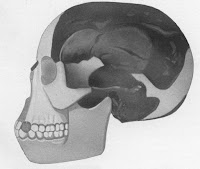The Piltdown forgery
 |
| A reconstruction of Piltdown Man, Wikimedia |
In case you're unfamiliar with the strange history of Piltdown Man, here's the story: In 1912, a man named Charles Dawson informed the Natural History Museum in London that he'd found some fossils and stone tools. The fossils consisted of some skull fragments and a jaw, all of which appeared to be quite old. The keeper of geology at the NHM, Arthur Smith Woodward, named it Eoanthropus dawsoni "Dawson's dawn man." For a time, it was a pretty sensational discovery, but its importance was later eclipsed by discoveries in Asia and Africa. It wasn't until the 1950s that Piltdown man was shown to be a hoax: the jaw of an ape and the skull of a human, all filed and stained to look very old. The question is: Who is the culprit?
Prior to this study, most of the evidence favored Dawson. He was the one who first brought these fossils to the public's attention, and he was the only one who had access to a supposed second site, from which he produced additional "fossils" before his death. He had wanted for years to be recognized for his discoveries in antiquities and maybe even become a Fellow of the Royal Society. In my estimation, the smoking gun was revealed earlier in this century, when a study of other "antiquities" discovered by Dawson uncovered dozens of other forgeries. Piltdown was apparently just a crowning achievement on a lifetime of faking and forging antiquities.
So what does this new study add to our knowledge? New CAT scans of the remains indicate a common modification methodology to all of the Piltdown man discoveries, indicating that they were all very likely the product of a single craftsman. DNA and morphometric analysis of the jawbone and teeth indicate that they probably came from a single orangutan. And that's it. These new findings rule out some of the other suspects, but the overwhelming evidence of Dawson's guilt isn't enhanced very much by these discoveries. This is reflected by De Groote et al.'s conclusion, where they call Dawson the "most likely" suspect:
The consistency in the MO observed in the specimens, and the use of a limited number of specimens to create both the Piltdown I and Piltdown II material, are indicative of a single forger. This was most likely Charles Dawson—the prime suspect since the fraud was exposed in 1953.What does the Piltdown story mean for us today? Honestly, I'm not sure it means all that much. Some creationists are obsessed with it, but it isn't really all that important. It's been more than sixty years since it was exposed, and there are hundreds of far more important and legitimate hominin fossils now known. I guess if there's a lesson to be learned, it might be something like this: Scientists are human, and they can make mistakes just like anyone else. Even when they make mistakes, though, it is through more scientific study that we can discover those mistakes. We creationists ought to take note: If we think the evidence for evolution or the ancient earth has been mistakenly interpreted by modern science, then it behooves us to do the scientific research needed to provide some other explanation for that huge body of evidence.
Hey! I guess that's an important lesson after all.
The article is open access, so you can read the whole thing for free right here:
De Groote et al. 2016. New genetic and morphological evidence suggests a single hoaxer created ‘Piltdown man.’ Royal Society Open Science 3:160328.
Feedback? Email me at toddcharleswood [at] gmail [dot] com. If you enjoyed this article, please consider a contribution to Core Academy of Science. Thank you.